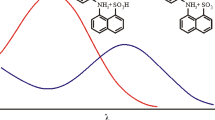Abstract
42 heterocyclic compounds, formally derived from alternant or nonalternant hydrocarbons by replacing a C=C group by an oxygen, nitrogen, sulfur or selenium atom, are studied by the Pariser-Parr-Pople-type of calculation. By means of these results the near ultraviolet and visible spectra are described. The sulfur and the selenium atoms are treated in the LCAO-MO-method using the p-model. In most cases spectral features are not only well reproduced, but interrelations of the spectra of iso-π-electronic compounds, possessing analogous structures are interpreted, too. On calculating cationic nitrogen heterocycles using parameters of pyrrol type nitrogen results are unsatisfactory.
Zusammenfassung
42 Heterocyclen, die sich formal von alternierenden und nichtalternierenden Kohlenwasserstoffen durch Ersatz einer Doppelbindung durch die Heteroatome Sauerstoff, Stickstoff, Schwefel und Selen ableiten, werden nach dem Pariser-Parr-Pople-Verfahren berechnet und ihre Spektren im nahen Ultraviolett und Sichtbaren beschrieben. Schwefel und Selen werden dabei im LCAO-MO-Verfahren nach dem p-Modell behandelt. In den meisten Fällen können die Berechnungen nicht nur die spektralen Charakteristika gut wiedergeben, sondern auch Beziehungen in den Spektren iso-π-elektronischer Verbindungen gleicher Struktur verständlich machen. Berechnungen an kationischen Stickstoffheterocyclen führten dann zu falschen Ergebnissen, wenn die Stickstoffparameter vom Pyrroltyp übernommen werden.
Résumé
42 composés hétérocycliques, formellement dérivés d'hydrocarbures alternants ou non alternants par remplacement d'un groupement C=C par un atome d'oxygène, d'azote, de soufre ou de sélénium, sont étudiés par la méthode de Pariser-Parr-Pople. Les résultats obtenus permettent de décrire le spectre U.V. proche et visible. Soufre et sélénium sont traités en utilisant le modèle p. Dans la plupart des cas les caractères spectraux sont non seulement correctement reproduits, mais les relations entre les spectres des composés iso-π-électroniques à structures analogues peuvent être interprétées. Les calculs concernant les heterocycles à azote cationique sont insatisfaisants lorsqu'ils sont effectués avec des paramètres de l'azote du type pyrrole.
Similar content being viewed by others
Literatur
Anderson, A. G., Jr., and H. L. Ammon: Tetrahedron Letters 1966 (23), 2579.
Badger, G. M., and B. J. Christie: J. chem. Soc. (London) 1956, 3438.
Berthod, H., C. Gießner-Prettre, and A. Pullman: Theoret. chim. Acta (Berl.) 5, 53 (1966).
Boyd, G. V.: J. chem. Soc. (London) 1958, 1978.
Brown, R. D., and M. L. Heffernan: Austral. J. Chem. 12, 554 (1959).
Chierici, L., e G. Pappalardo: Gazz. chim. ital. 88, 453 (1958).
Clemo, G. R., and D. G. I. Felton: J. chem. Soc. (London) 1952, 1658.
Degani, J., R. Fochi e C. Vincenzi: Gazz. chim. ital. 94, 203 (1964).
— — e G. Spunta: Boll. sci. Fac. Chim. ind. Bologna 23, 165 (1965).
— — —: Boll. sci. Fac. Chim. ind. Bologna 23, 151 (1965).
De Giambiago, M. S., M. Giambiago u. R. Ferreira: J. Chim. physique Physico-Chim. biol. 61, 697 (1964).
Mc Ewen, K. L.: J. chem. Physics 34, 547 (1961).
Fabian, J., A. Mehlhorn u. R. Zahradnik: J. physic. Chem. (im Druck) (1968).
Friedel, R. A., and M. Orchin: Ultraviolet Spectra of Aromatic Compounds, New York: Wiley 1951.
Gil, M. S., and J. N. Murrell: Trans Faraday Soc. 60, 248 (1967).
Gosselck, J.: Angew. Chemie 75, 831 (1963).
Hochmann, P., R. Zahradník, and V. Kvasnička: Collect. Czechoslov. Chem. Commun. (im Druck).
Jaffé, H. H., and M. Orchin: Theory and Applications of UV Spectroscopy. New York: Wiley 1962.
Jones, J. I., and A. S. Lindsey: J. chem. Soc. (London) 1950, 1836.
Julg, A.: J. Chim. physique Physico-Chim. biol. 55, 413 (1958).
Klevens, H. B., and J. R. Platt in J. R. Platt: Electronic Spectra of Conjugated Molecules, Paper 10, New York: Wiley 1964.
Kruber, O., and G. Grigoleit: Chem. Ber. 87, 1895 (1954).
Kwiatkowski, J. S.: Bull. Acad. polon. Sci. Ser. Sci. chim. 13, 817 (1965).
Lang, L.: Absorption Spectra in the Ultraviolet and Visible Region. Budapest: Académiai Kiado1959.
Mack, W.: Angew. Chemie 78, 940 (1966).
Mataga, N., and K. Nishimoto: Z. physik. Chem. (N.F.) 13, 140 (1957).
Momicchioli, F., and A. Rastelli: J. molecular Spectroscopy 22, 310 (1967).
Nishimoto, K.: Theoret. chim. Acta (Berl.) 10, 65 (1968).
O'Brien, S., and D. C. C. Smith: J. chem. Soc. (London) 1963, 2907.
Pariser, R.: J. chem. Physics 21, 568 (1953).
Perkins, P. G.: J. molecular Spectroscopy 22, 464 (1967).
Price, W. C., J. P. Teegan, and A. D. Walsh: Proc. Roy. Soc. (London) 201 A, 600 (1950).
Pritchard, H. O., and W. A. Skinner: Chem. Reviews 55, 745 (1955).
Replogle, L. L., K. Katsumoto, and T. C. Morrill: Tetrahedron Letters 1965, (23), 1877.
— — —, and C. A. Minor: J. org. Chemistry 33, 823 (1968).
—: J. Amer. chem. Soc. 86, 3137 (1964).
Sawicki, E.: J. org. Chemistry 19, 1163 (1954).
Solony, N., F. W. Birss, and J. B. Greenshields: Canad. J. Chem. 43, 1569 (1965).
Toyoda, K.: J. chem. Soc. Japan, pure Chem. Sect. (Nippon Kagaku Zasshi) 87, 32 (1966).
Treibs, W., W. Schroth, H. Lichtmann u. G. Fischer: Liebigs Ann. Chem. 642, 97 (1961).
— —: Liebigs Ann. Chem. 642, 82 (1961).
Trombetti, A., and C. Zauli: J. chem. Soc. (London) (A) 1967, 1106.
UV-Atlas organischer Verbindungen (DMS-Kartei) Weinheim: Verlag Chemie 1966.
Watanabe, K., T. Nakayma, and J. Mottl: J. quant. Spectroscopy Radiat. Transfer 2, 369 (1962).
Zimmermann, H., and N. Joop: Z. Elektrochemie 65, 61 (1961).
Author information
Authors and Affiliations
Additional information
Anmerkung: Die Arbeit wurde in dem von Prof. Dr. R. Mayer geleiteten Schwefelarbeitskreis der TU Dresden durchgeführt.
Rights and permissions
About this article
Cite this article
Fabian, J., Mehlhorn, A. & Zahradník, R. PPP-Berechnungen und Vergleich der Elektronenspektren von iso-π-elektronischen Sauerstoff-, Stickstoff-, Schwefel- und Selenheterocyclen. Theoret. Chim. Acta 12, 247–255 (1968). https://doi.org/10.1007/BF00528272
Received:
Issue Date:
DOI: https://doi.org/10.1007/BF00528272




